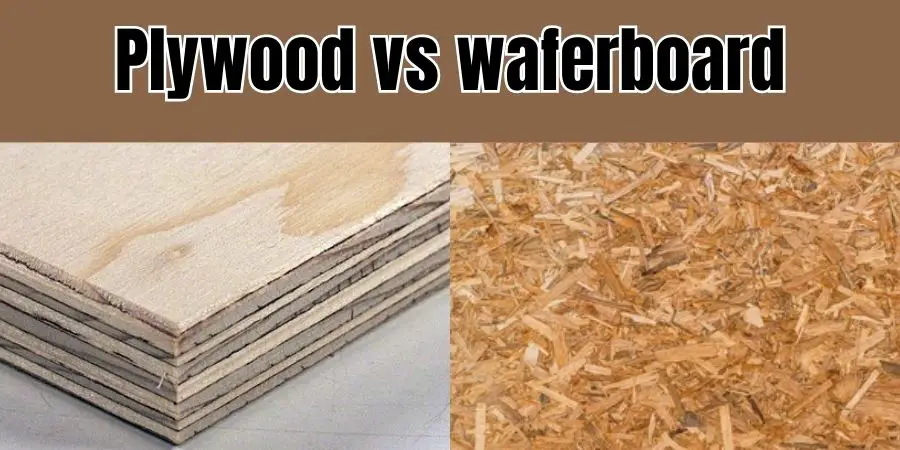Waferboard and plywood are two commonly used engineered wood products that are used in construction and furniture-making. They both have their own strengths and limitations, and are better suited for different applications depending on the specific needs and priorities.
Understanding the differences between waferboard and plywood can help you make an informed decision on which material to use for your next project.
What is waferboard?
Waferboard, also known as oriented strand board (OSB), is a precisely engineered wood product that’s created by layering thin strands of wood in a specific orientation and then pressing them together with the help of heat and resin.
Think of it like a gourmet sandwich where the ingredients are carefully chosen and arranged for maximum flavor and texture. The resulting waferboard is strong, durable, and perfect for construction projects where strength and stability are a top priority.
What is plywood?
Plywood is like a sandwich, but instead of bread, it’s made of thin sheets of wood called plies or veneers. And instead of meat, cheese, and veggies, it’s glued together with pressure and heat to create a strong, lightweight, and versatile panel that’s perfect for a wide range of projects. So next time you’re building something, think of plywood as the sandwich bread that holds it all together!
Which one should i choose? Waferboard or Plywood
If you need a strong and durable material for structural applications, waferboard may be the better choice.
If you need a versatile material with an attractive appearance for decorative applications, plywood may be the better choice. It’s also important to consider factors such as cost, availability, and environmental impact when making your decision.
Table of Contents
Comparison- Plywood vs Waferboard
Manufacturing process:
The main difference between waferboard and plywood is the way they are manufactured.
Waferboard is made by layering thin strands of wood in a specific orientation and then pressing them together with heat and resin, while plywood is made by layering thin sheets of wood, called plies or veneers, in alternating directions and then gluing them together with pressure and heat.
Appearance:
Another difference between waferboard and plywood is their appearance.
Waferboard has a rough and textured surface with visible wood strands, while plywood has a smooth surface with visible wood grain patterns.
Strength and durability:
In terms of strength and durability, waferboard is generally stronger and more durable than plywood.
The specific orientation of the wood strands in waferboard makes it less likely to split or crack, while the alternating layers of plywood provide greater stability and resistance to warping.
Moisture resistance:
One potential disadvantage of waferboard is that it can be more susceptible to moisture damage than plywood, which can lead to swelling, warping, or delamination.
Plywood, on the other hand, is generally more moisture-resistant and can be used in applications that will be exposed to water or humidity.
Cost:
Finally, cost can be a factor to consider when choosing between waferboard and plywood. In general, waferboard is less expensive than plywood, although the specific cost will depend on the quality and type of wood used.
Plywood vs waferboard- which one should you choose?
The decision to use waferboard or plywood will ultimately depend on the specific application and your priorities. Here are some guidelines to help you decide which material to use for different applications:
Subflooring and Roofing:
For subflooring and roofing applications, waferboard is generally a better choice due to its strength and durability. These applications require a material that can withstand heavy loads and resist damage from moisture and humidity.
Wall Sheathing:
Waferboard and plywood can both be used for wall sheathing, but plywood is generally a better choice if appearance is a concern. Plywood has a smooth surface with visible wood grain patterns, which can give it a more attractive and natural appearance.
Furniture and Cabinetry:
Plywood is often preferred for furniture and cabinetry due to its smoother surface and attractive appearance. Waferboard may be suitable for lower-end or industrial-style furniture, but for higher-end or more decorative applications, plywood is generally the better choice.
Pros and cons
Waferboard Pros:
- Affordable like a good happy hour deal
- Strong and durable, like a superhero with a sturdy shield
- Resistant to warping and twisting, so it won’t throw a tantrum like a diva
Waferboard Cons:
- Prone to swelling and water damage, like a water balloon in a rainstorm
- Not as visually appealing as plywood, like an awkward first date
- Can have a rough and uneven surface, like a bumpy rollercoaster ride
Plywood Pros:
- Attractive with its visible wood grain, like a model on a runway
- Strong and stable, like a reliable sidekick
- Resistant to water damage and decay, like a vampire avoiding sunlight
Plywood Cons:
- More expensive than waferboard, like a fancy night out
- Can splinter or delaminate, like a bad hair day
- Not as environmentally friendly as waferboard, like a gas-guzzling SUV





